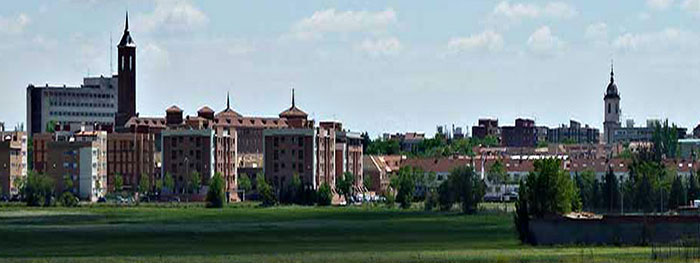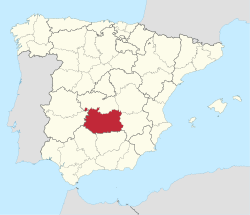Ciudad Real in Ciudad Real

The province of Ciudad Real is one of the five provinces that constitute the autonomous region of Castilla - La Mancha. It is in the south-west of the region bordering on Toledo, Cuenca, Albacete, Jaén, Córdoba and Badajoz. There is another little bit of Ciudad Real - a small exciave called Anchuras, cut off from the region of Ciudad Real by a strip of land belonging to Badajoz and wedged in between Toledo, Badajoz and Cáceres.
The region covers a total of 19,813 km2 and has mountain ranges in the north and the south, Montes de Toledo and Sierra Morena respectively. The highest point in the region is in Montes de Toledo.
It is called Pico Amor and it is 1,379 m high.
In between the mountains we find a large part of the Plains of La Mancha, which are famous for the production of Manchego cheese and wine amongst other delights. Not to mention Don Quixote and windmills!
The population of Ciudad Real is 502,578 (2017) distributed on 102 municipalities. The largest city is its capital of the same name, which is home to 74,641 souls (2017).
Ciudad Real is also still popularly known as Capital de La Mancha, as this was in fact its status back when La Mancha was a Spanish region.
The city’s inland location means the climate is so-called Mediterranean continental with bigger differences between day! night and summer/winter temperatures than on the coast. The rainfall averages 400mm per year, the largest amount falling in autumn and early winter, and little or no rain in summer. The summers are hot with maximum temperatures well into the thirties.
Sadly, due to lack of maintenance over the centuries, Ciudad Real lacks in historical monuments and buildings, and apart from the cathedral, Catedral de Nuestra Señora del Prado, and a few churches, the only really noteworthy monument is the Puerta de Toledo, a magnificent example of military architecture from the 14th century, built under King Alfonso XI of Castile. The old entrance gate to Ciudad Real has recently been restored.
Ciudad Real’s economy is mainly based on the service sector. The city is home to a big university and has a large student population. Agriculture also plays an important part, and both the region and the city produce a large number of D.O. (Denominación de Origen) products. These in turn have led to large trade fairs being held in Ciudad Real annually.
History

Originally there was a small settlement called Pozo Seco de Don Gil (Don Gil’s Dry Well) which exploded into a large town during the Reconquista, when the Catholic Kings encouraged people to move into the area and claim the ‘nobody’s land’ that had been left when the Moors left the area. Today there is a plaque in Plaza del Pilar marking the situation of the original settlement.
The area was ruled by military orders, whose leaders behaved like feudal lords, until King Alfonso X the Wise founded a royal town there, which he named Villa Real, to put an end to the military rule.
In 1420, King Juan II of Castile bestowed the title ‘city’ on Villa Real in gratitude for their help and loyalty in sending 1,500 troops to support him when he was held prisoner in Montalbán castle. Villa Real became Ciudad Real and received the inscription ‘Very noble, very loyal’ on its shield.
In 1691, Ciudad Real became the capital of La Mancha, and in 1833 the province of Ciudad Real was created, and the city became its capital and administrative centre.
The railway arrived in Ciudad Real in 1863, and apart from providing the city with an easy connection to the outside world, the construction work also involved drying out some nearby disease infected ponds which had caused countless illnesses and deaths in certain areas of the city.
Ciudad Real was one of the 49 provinces in which Spain was divided in the territorial reorganization of 1833, taking its name from its largest city and capital. Its limits corresponded more or less to the historical province of La Mancha, which was part of the kingdom of Toledo.
The Spanish government created the autonomous community of Castilla-La Mancha on 15 November 1978, as one of several autonomous regions. The new, hyphenated name was chosen to join the historic Castilla region, which extended beyond the new autonomous region, and that of the smaller historic province of La Mancha. Initially a "pre-autonomous" region, the reorganization proposal finally took effect one week after the Statute of Autonomy of Castilla–La Mancha was approved on 10 August 1982.
Under this new arrangement, Castilla-La Mancha was subdivided into five provinces, Albacete, Ciudad Real, Cuenca, Guadalajara and Toledo, each named after its largest town and capital city. The province of Ciudad Real was further subdivided into six comarcas (administrative districts), these being:
Valle de Alcudia
Campo de Calatrava
Mancha
Montes
Montiel
Sierra Morena


